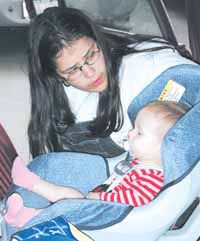| Cindy Miller ensures that daughter Ashlyn is secured properly in a child safety seat before traveling. It is extremely important to use safety seats properly so that youngsters will not incur serious injuries in the event a traffic accident should occur. Safety checkpoints like the one conducted last Thursday at Community Motors in Price offer Carbon County parents information along with instruction as to how to restrain children properly in the car seats. Safety devices may be brought to the local health department where further advice may be given and proper use may be displayed. |
The United States Department of Transportation’s National Highway Traffic Safety Administration requires all newly installed child safety restraints to have a specialized method of attaching to the seat of a motor vehicle seat.
The nationwide requirement became effective on Sept. 1.
Lower anchors and tethers for children or LATCH is a restraint system designed to work independently of the vehicle seat belt system to simplify child safety seat installation and reduce misuse.
Since Sept. 1, 2000, all vehicle manufacturers have been required to install a top tether anchor in their vehicles.
In addition, vehicle manufacturers were required to begin installing lower anchors in at least two rear seating positions in nearly all new passenger vehicles.
All passenger vehicles manufactured after Sept. 1, 2002 will have the LATCH system.
Along with the new LATCH requirements, most child safety seats will be required to have a lower set of attachments that fasten to the vehicle anchors.
Most forward-facing child safety seats also have a top strap that attaches to a tether anchor in the motor vehicle. Combined, the strap and tether anchor make up the LATCH system.
“LATCH is an important innovation in child restraint and vehicle design. When used properly the system is expected to save up to 50 lives a year and prevent close to 3,000 injuries in a crash. This new technology will help us move forward in our effort to further reduce death and injury among our youngest passengers,” commented NHTSA administrator Dr. Jeffrey Runge.
The safety administration estimates that as many as 80 percent of child safety seats are incorrectly used.
The federal agency also estimates that the LATCH system will eliminate as much as half of the misuse associated with the improper installation of child safety seats.
Child safety seats without LATCH technology are still effective in protecting children as long as the devises are correctly installed in accordance with the manufacturer’s instructions.
“The LATCH restraint system will make child restraints easier to use, simpler and more secure,” explained Runge. “It will be easier for parents to do the right thing to protect their children.”
Although the LATCH system will help resolve installation misuse, parents and drivers must still be sure to perform the following installation techniques.
•Place children in an appropriate safety seat. Make sure that the child is the appropriate height, weight and/or age for the child safety seat.
•Place children in the back seat. The back seat is the safest place for children.
•Never place a rear-facing child restraint in the front seat with an air bag.
•Install the child safety seat properly in the vehicle.
•Check that the child safety seat harness straps are tight.
•Place children in a booster seat once they reach 40 pounds.
•Do not prematurely move children to an adult seat belt system. Children should continue to ride in a booster seat in the back seat if they are under four feet, nine inches tall.
•Stay informed as to whether a child safety seat has been recalled.
Carbon County consumers can have child passenger safety questions answered by calling NHTSA’s Auto Safety Hotline at toll-free at 1-888-327-4236.
Local residents may also contact the Southeastern Utah Health District office in Price.
Child safety seats may be inspected by licensed safety personnel. To find obtain information regarding safety inspection assistance, residents may contact Georgina Nowak at the health district at 637-3671.

